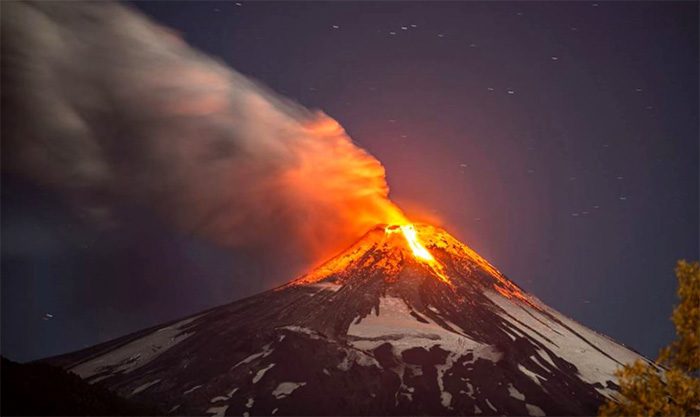Large-scale volcanic eruptions are the result of the accumulation of molten rock hundreds of kilometers beneath the Earth’s surface over millions of years. This is the finding of a study published in the latest issue of the journal Nature.
Volcanologist Professor Stephen Sparks from the University of Bristol (UK) stated that the last supereruption occurred 26,000 years ago. Professor Sparks has led an international research project in the Andes, northern Chile, where several large-scale volcanic eruptions took place many years ago, aiming to provide early warnings and forecasts for future eruptions.

Villarrica Volcano in Southern Chile erupting lava.
Professor Sparks noted that these eruptions occurred a long time ago in the Andes. Scientists can evaluate the entire process of how magma is generated and erupts. Although these phenomena are rare, there are certainly certain patterns of eruptions. This phenomenon reflects the process of a large amount of molten rock accumulating over a long period, which then quickly rises to the Earth’s surface and erupts.
During their investigation, researchers used radioactive isotopes to date small crystals ejected from the volcano, revealing that they date back 2-3 million years before the eruption occurred. This indicates that the processes leading to large-scale eruptions can extend over millions of years.
The research in the Andes is part of a project supporting the mining company BHP. This company is drilling deep through volcanic rock layers in northern Chile to explore copper mining. Currently, the main concern for researchers is the frequency of such massive eruptions. Through their studies, scientists estimate that the frequency of eruptions on Earth is approximately every 20,000 years. The most recent eruption of this scale occurred in New Zealand about 26,000 years ago.
Statistics show that there are about 1,500 volcanoes that have been active on Earth, including approximately 50 supereruptions. Such eruptions can affect areas covering hundreds of thousands of square kilometers through rapid and large lava flows or significant amounts of volcanic ash falling to the ground. The greatest concern is that these types of eruptions can pollute the atmosphere for years by producing large amounts of dust and gases such as sulfur. These gases can impact the climate by cooling the planet rather than warming it over several years.
The new study will help experts better understand the causes of unusual volcanic activity. According to scientists, a large amount of molten rock must accumulate underground over a long time before there is enough energy for this magma to rise and erupt. Based on this research, scientists are beginning to formulate hypotheses regarding the causes of sudden eruptions.


















































